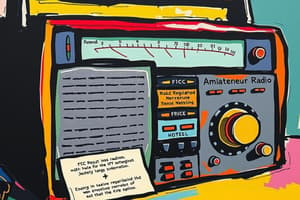Podcast
Questions and Answers
All radio communications in the United States are regulated by the _________.
All radio communications in the United States are regulated by the _________.
Federal Communications Commission (FCC)
You are providing a patient report via radio to medical direction. Your report should include _________.
You are providing a patient report via radio to medical direction. Your report should include _________.
a summary of care
As you are assessing a 75-year-old woman with mild shortness of breath, what is important to remember when moving closer?
As you are assessing a 75-year-old woman with mild shortness of breath, what is important to remember when moving closer?
As you physically get closer to the patient, a greater sense of trust must be established.
In which manner should you act and speak with a patient?
In which manner should you act and speak with a patient?
Which of the following statements regarding communication with a child is correct?
Which of the following statements regarding communication with a child is correct?
When communicating with a visually impaired patient, what should you do?
When communicating with a visually impaired patient, what should you do?
What should you do when you arrive at a scene and the patient does not speak English?
What should you do when you arrive at a scene and the patient does not speak English?
When you begin an oral report, you should state the patient's age, sex, and _________.
When you begin an oral report, you should state the patient's age, sex, and _________.
The patient care report (PCR) ensures:
The patient care report (PCR) ensures:
What should you do when completing your PCR after a call?
What should you do when completing your PCR after a call?
What should you do if a patient refuses EMS treatment and transport?
What should you do if a patient refuses EMS treatment and transport?
Any radio hardware containing a transmitter and a receiver that is located in a fixed location is called a:
Any radio hardware containing a transmitter and a receiver that is located in a fixed location is called a:
A ___________ receives messages and signals on one frequency and then automatically retransmits them on a second frequency.
A ___________ receives messages and signals on one frequency and then automatically retransmits them on a second frequency.
After being dispatched on an emergency call, what information should you expect from the dispatcher, EXCEPT:
After being dispatched on an emergency call, what information should you expect from the dispatcher, EXCEPT:
When communicating information over the radio, you should:
When communicating information over the radio, you should:
What is important to remember when obtaining patient care orders from a physician via a two-way radio?
What is important to remember when obtaining patient care orders from a physician via a two-way radio?
Which of the following statements regarding standing orders is correct?
Which of the following statements regarding standing orders is correct?
Two-way communication that requires the EMT to 'push to talk' and 'release to listen' describes which mode of communication?
Two-way communication that requires the EMT to 'push to talk' and 'release to listen' describes which mode of communication?
What should you do to correct an error made in the handwritten PCR?
What should you do to correct an error made in the handwritten PCR?
To facilitate effective communication among response agencies during a multi-agency incident, what should be utilized?
To facilitate effective communication among response agencies during a multi-agency incident, what should be utilized?
Flashcards are hidden until you start studying
Study Notes
Communication Regulations
- All radio communications in the U.S. are regulated by the Federal Communications Commission (FCC).
Patient Reporting via Radio
- A patient report to medical direction should include a summary of care.
Building Trust with Patients
- As the EMT approaches a patient, progressively moving closer increases trust, establishing a connection.
Patient Interaction
- EMTs should act and speak with patients in a calm and confident manner to foster reassurance.
Communicating with Children
- Standing over a child can increase anxiety, highlighting the need for an approachable stance.
Addressing Visual Impairments
- Determine the degree of the patient's impairment when communicating with visually impaired patients.
Language Barriers in Patient Care
- Use short, simple questions and gestures to communicate effectively with patients who do not speak English.
Oral Patient Report Essentials
- Begin an oral report with the patient's age, sex, and chief complaint.
Patient Care Report (PCR) Importance
- The PCR ensures continuity of care among healthcare providers.
Completing Electronic PCR
- Always include a thorough and accurate narrative as drop-down boxes cannot capture all necessary information.
Handling Patient Refusal
- If a patient refuses to sign a refusal form, ask a third party to sign as a witness to the refusal.
Radio Communication Equipment
- A base station is a fixed-location radio hardware that contains both a transmitter and a receiver.
Repeaters in Communication
- A repeater receives and retransmits messages on different frequencies.
Dispatcher Information
- Expect the dispatcher to provide critical information, except for the general geographic location of the incident.
Radio Communication Protocol
- Use "affirmative" and "negative" instead of "yes" or "no" when communicating over the radio.
Orders from Medical Control
- Physicians' orders received over the radio are based on the EMT's provided information.
Standing Orders Protocol
- Standing orders should be followed when direct physician contact is not possible.
Two-way Communication System
- Simplex communication requires the EMT to "push to talk" and "release to listen".
Correcting Errors in Documentation
- For documentation errors, draw a horizontal line through the mistake, initial it, and write the correct information next to it.
Interagency Communication
- An interoperable communications system should be utilized during multi-agency emergency responses for effective coordination.
Studying That Suits You
Use AI to generate personalized quizzes and flashcards to suit your learning preferences.




